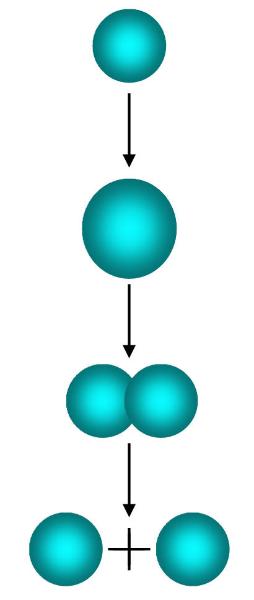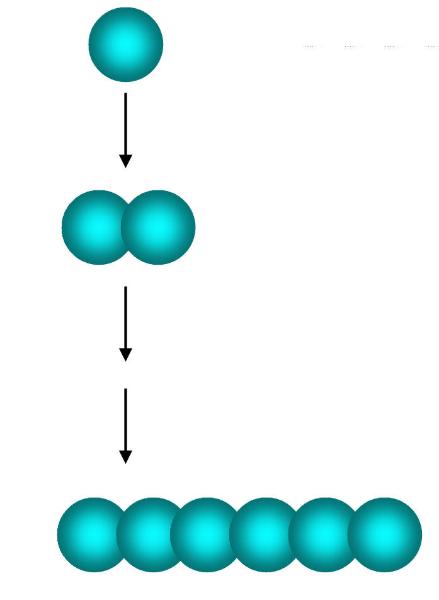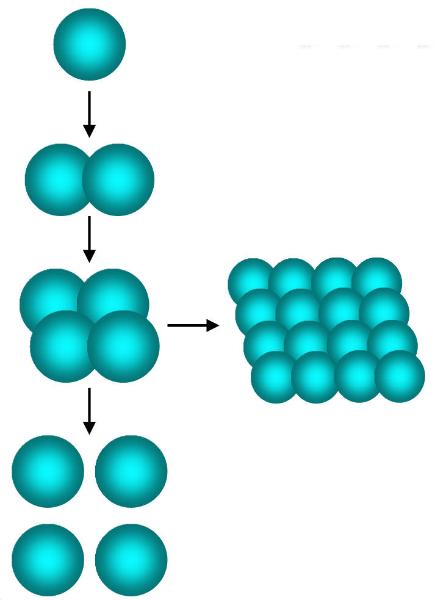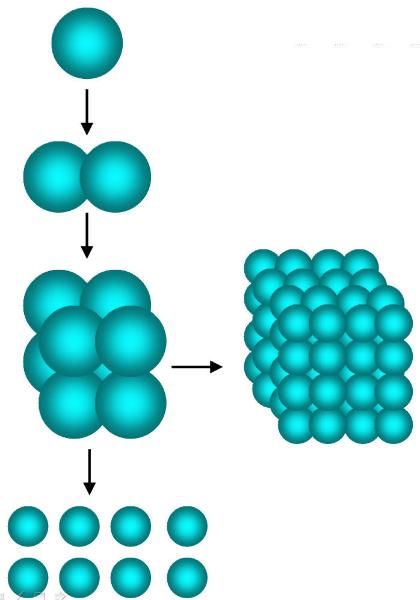Remember that a human being contains something like 10 million million cells. Before we say why this is a
handy thing, we shall talk about how this came about, because the ancestor of all animals was undoubtedly a
single celled organism, rather like the amoeba on Cells page 2.
Many cells reproduce by dividing and they divide by a process of binary fission, called mitosis in eukaryotes, -
that is they split into two new cells when the old cell grows too big, as shown below. As well as producing new
cells required for the maintenance of tissues and organs in the adult animal, mitosis is also essential in growth
and development.
handy thing, we shall talk about how this came about, because the ancestor of all animals was undoubtedly a
single celled organism, rather like the amoeba on Cells page 2.
Many cells reproduce by dividing and they divide by a process of binary fission, called mitosis in eukaryotes, -
that is they split into two new cells when the old cell grows too big, as shown below. As well as producing new
cells required for the maintenance of tissues and organs in the adult animal, mitosis is also essential in growth
and development.
So our cell ate lots of food, grew large and split into new daughter cells. Now, supposing we get a mutant. A
mutant is a cell whose genes are altered in some way so that it does different things. Now imagine that this
mutant starts dividing but the process goes wrong and the daughter cells do not separate properly. In the end a
chain or filament of cells will form as shown on the right. This chain will eventually break in two when it gets too
long. This isn't necessarily a bad thing because there is strength in numbers. Imagine that these cells need
light, then the long chain of cells has a possible advantage since it can grow taller than its neighbours - many
photosynthetic bacteria and algae are just such chains of cells! Wow! Now we have a multicellular organism!
(Albeit with only a few cells).
Not all cells divide by simple binary fission, some other possibilities are shown in the pictures below:
mutant is a cell whose genes are altered in some way so that it does different things. Now imagine that this
mutant starts dividing but the process goes wrong and the daughter cells do not separate properly. In the end a
chain or filament of cells will form as shown on the right. This chain will eventually break in two when it gets too
long. This isn't necessarily a bad thing because there is strength in numbers. Imagine that these cells need
light, then the long chain of cells has a possible advantage since it can grow taller than its neighbours - many
photosynthetic bacteria and algae are just such chains of cells! Wow! Now we have a multicellular organism!
(Albeit with only a few cells).
Not all cells divide by simple binary fission, some other possibilities are shown in the pictures below:
On the left we have a cell that
reproduces by dividing in two planes
instead of just one, to form a plate of
cells that separate. Now if these cells
fail to separate we end up with a sheet
of cells. Some organisms are like this -
they are sheets of cells!
Animals, including humans, develop
from a sheet of cells that has been
rolled up into a hollow cylinder!
reproduces by dividing in two planes
instead of just one, to form a plate of
cells that separate. Now if these cells
fail to separate we end up with a sheet
of cells. Some organisms are like this -
they are sheets of cells!
Animals, including humans, develop
from a sheet of cells that has been
rolled up into a hollow cylinder!
On the left we have a cell that divides in
three dimensions. Failure of the cells to
separate results in a cube or ball of cells.
Many organisms are balls or cubes of a few
cells!
three dimensions. Failure of the cells to
separate results in a cube or ball of cells.
Many organisms are balls or cubes of a few
cells!
So you see, we have ended up creating some relatively simple multicellular organisms! This is how nature
works - she takes simpler things and joins them together in such a way as to make more complex things!
Still we are a long way from a human being! We need a few more processes, the first of which is called division
of labour. Having lots of cells is useful, for a start different cells can do different things, some may specialise in
catching food, others in sensing the environment and others in reproduction, and so on. The same thing has
happened in human society - all humans were originally hunter-gatherers, but now there are electricians,
builders, doctors, and so on. In single-celled organisms like the amoeba, one cell has to do everything and that
gets tricky! Division of labour allows each cell to specialise at what its good at. Imagine our cube of cells,
imagine some growing appendages that move the colony around, whilst others from a gut for feeding - now we
have an animal! Still, a relatively simple animal (living things are never ever simple!), so what else do we need
to do to make a human being?
Click here to see how to build a complex animal body.
Click here to learn about multicellularity in plants.
works - she takes simpler things and joins them together in such a way as to make more complex things!
Still we are a long way from a human being! We need a few more processes, the first of which is called division
of labour. Having lots of cells is useful, for a start different cells can do different things, some may specialise in
catching food, others in sensing the environment and others in reproduction, and so on. The same thing has
happened in human society - all humans were originally hunter-gatherers, but now there are electricians,
builders, doctors, and so on. In single-celled organisms like the amoeba, one cell has to do everything and that
gets tricky! Division of labour allows each cell to specialise at what its good at. Imagine our cube of cells,
imagine some growing appendages that move the colony around, whilst others from a gut for feeding - now we
have an animal! Still, a relatively simple animal (living things are never ever simple!), so what else do we need
to do to make a human being?
Click here to see how to build a complex animal body.
Click here to learn about multicellularity in plants.




| Building Bodies - Multicellularity |